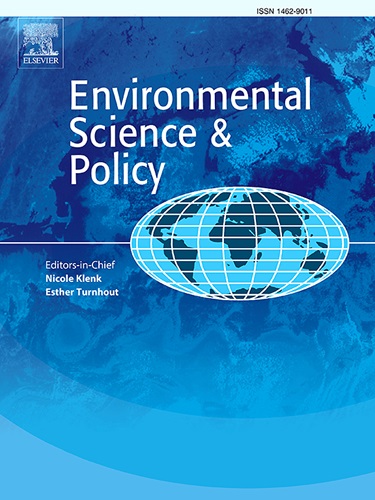Challenge accepted – identifying barriers and facilitating climate change adaptation in spatial development across planning boundaries, sectors and planning levels
IF 5.2
2区 环境科学与生态学
Q1 ENVIRONMENTAL SCIENCES
引用次数: 0
Abstract
Spatial planning influences diverse sectors, including housing, industry, forestry, agriculture, tourism, and nature conservation. Accordingly, climate change adaptation (CCA) strategies stress the need to integrate climate considerations into spatial plans, programs, and response strategies. However, prior studies highlight gaps in cooperation across planning levels, sectors and borders, as well as insufficient integration of sectoral data. Therefore, this paper (i) identifies and classifies challenges arising from existing CCA efforts across planning areas, levels, and sectors; (ii) investigates structural mechanisms underlying key cooperation barriers; and (iii) outlines leverage points to promote integrated spatial planning for climate resilience. Empirical findings from qualitative interviews and workshops using backcasting methods with case studies enable comparison across governance levels and federal states, shedding light on vertical and horizontal collaboration and disciplinary perspectives.
Results show that transparent communication of trade-offs and co-development of synergistic solutions remain rare, largely driven by individual initiative rather than institutional practices or frameworks. This poses a challenge given spatial planning’s coordinating role. Nonetheless, the analysis results reveal growing interest from sectors such as water management, forestry, green space planning, and geology to formally engage with spatial planners. A key barrier is the diversity of planning instruments across governance levels and the limited capacity to interpret them cross-sectorally, reflecting broader issues around institutional and individual capacity, resources, and knowledge. This paper contributes to the discourse on enabling transformative change, identifying leverage points for a strategic, integrated spatial planning approach that incorporates CCA, informed by sectoral expertise and applicable across planning hierarchies and boundaries.
接受挑战-识别障碍并促进跨规划边界、部门和规划水平的空间发展适应气候变化
空间规划影响着各个领域,包括住房、工业、林业、农业、旅游和自然保护。因此,气候变化适应(CCA)战略强调将气候因素纳入空间规划、方案和响应策略的必要性。然而,先前的研究强调了跨规划层面、部门和边界的合作差距,以及部门数据整合不足。因此,本文(i)确定并分类了现有CCA在规划领域、层面和部门的努力所带来的挑战;(ii)调查关键合作障碍背后的结构性机制;(三)概述了促进气候适应能力综合空间规划的杠杆点。定性访谈和研讨会的实证研究结果使用回溯法和案例研究,可以在治理级别和联邦州之间进行比较,揭示垂直和横向合作以及学科观点。结果表明,透明的权衡沟通和协同解决方案的共同开发仍然很少,主要是由个人的主动性而不是机构的实践或框架驱动的。这对空间规划的协调作用提出了挑战。尽管如此,分析结果显示,水资源管理、林业、绿地规划和地质等部门对与空间规划师正式合作的兴趣日益浓厚。一个关键的障碍是不同治理级别的规划工具的多样性,以及跨部门解释它们的能力有限,这反映了围绕机构和个人能力、资源和知识的更广泛的问题。本文为实现转型变革的论述做出了贡献,为包含CCA的战略性综合空间规划方法确定了杠杆点,该方法由部门专业知识提供信息,并适用于规划层次和边界。
本文章由计算机程序翻译,如有差异,请以英文原文为准。
求助全文
约1分钟内获得全文
求助全文
来源期刊

Environmental Science & Policy
环境科学-环境科学
CiteScore
10.90
自引率
8.30%
发文量
332
审稿时长
68 days
期刊介绍:
Environmental Science & Policy promotes communication among government, business and industry, academia, and non-governmental organisations who are instrumental in the solution of environmental problems. It also seeks to advance interdisciplinary research of policy relevance on environmental issues such as climate change, biodiversity, environmental pollution and wastes, renewable and non-renewable natural resources, sustainability, and the interactions among these issues. The journal emphasises the linkages between these environmental issues and social and economic issues such as production, transport, consumption, growth, demographic changes, well-being, and health. However, the subject coverage will not be restricted to these issues and the introduction of new dimensions will be encouraged.
 求助内容:
求助内容: 应助结果提醒方式:
应助结果提醒方式:


